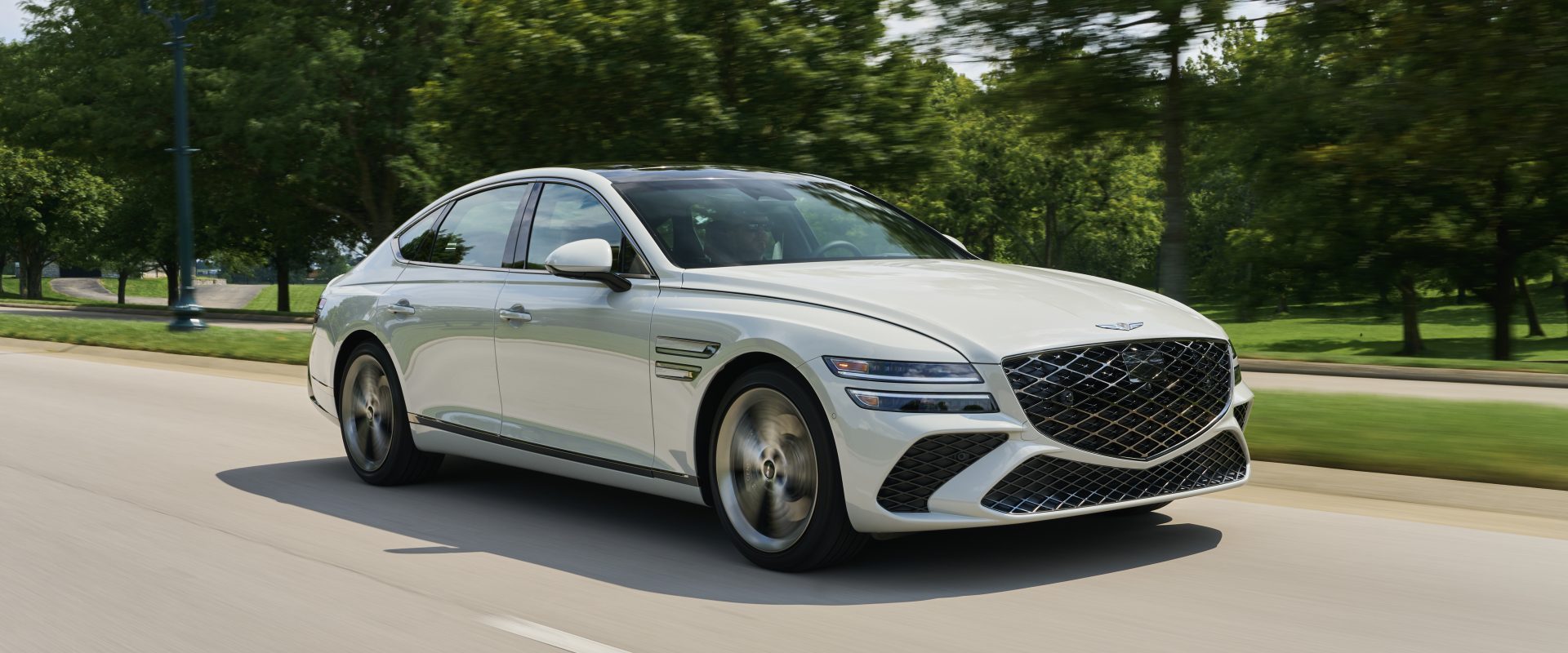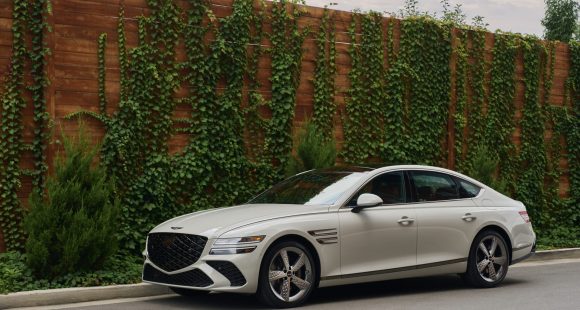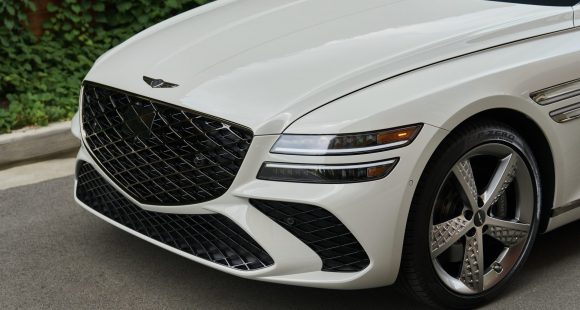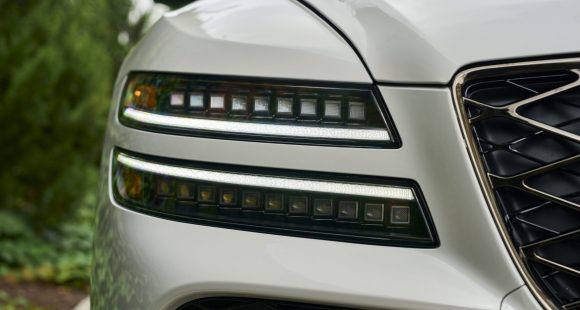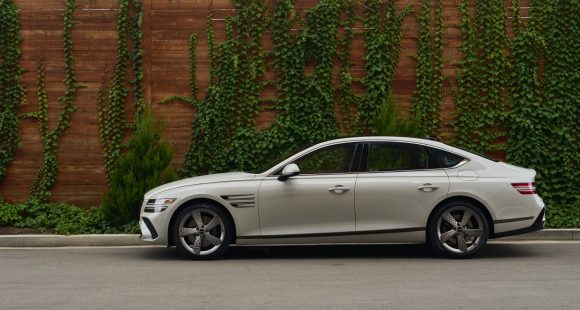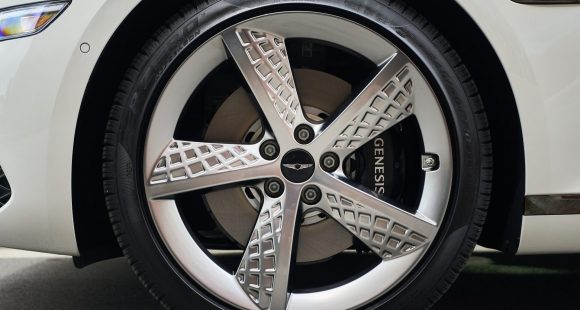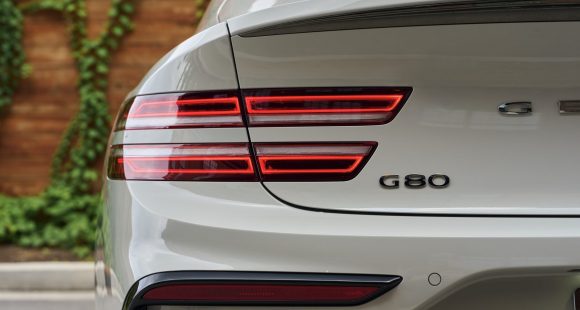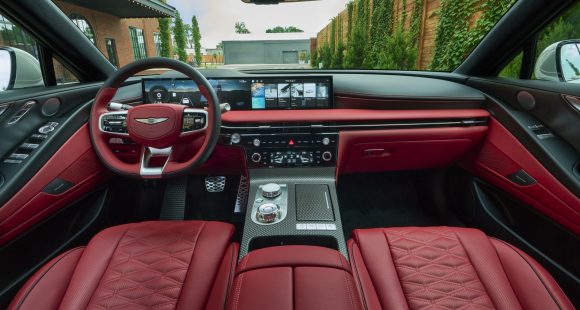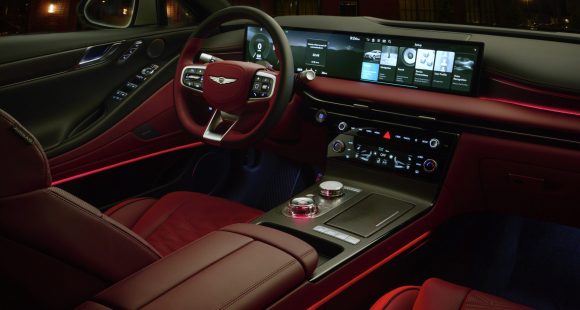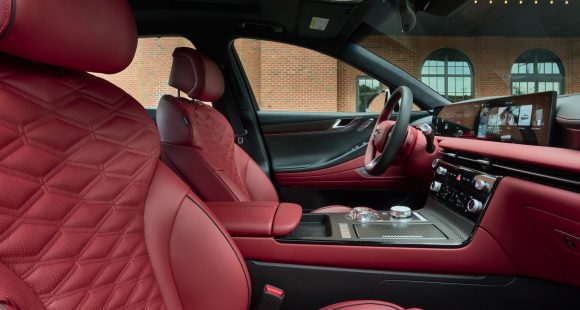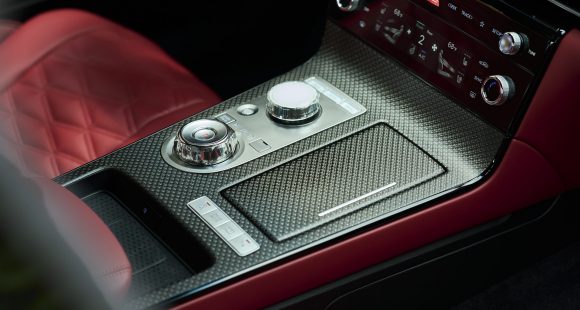2017 GMC Acadia
One constant you can put up there with death and taxes, is people always want more. So, it’s usually the case for each new generation of vehicle to get bigger and bigger. Well, GM has proved before they’re not afraid to give people more from less, and that’s the story behind this new GMC Acadia, so let’s hear more about it.
Trivia question: what was the first modern 3-row crossover? If you said the 2007 Saturn Outlook, congratulate yourself. If you said the 07’ GMC Acadia; well, you’re half right as it did share its chassis with the Outlook. And if you’re saying “what is a Saturn?” Well, you’ll have to google it, as we must move on and start talking about this 2017 GMC Acadia.
Trim is in, and no one has been on more of a weight-loss kick than General Motors. Now sharing a chassis with the Cadillac XT5, its 700-lbs. lighter than the outgoing Acadia. That’s due to a shrunken exterior size, more high strength steel, and a smaller 193-horsepower 2.5-liter I4 engine that is now standard. But, even with the V6, it’s some 600-lbs. lighter.
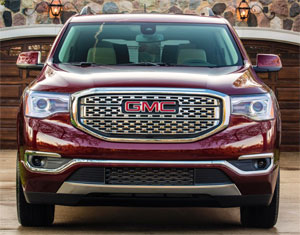 That 3.6-liter V6 is now optional and it’s also a new one, putting out both more horsepower at 310, and more torque at 271 lb-ft. Yet despite the bigger numbers, towing capacity falls from 5,200-lbs to 4,000, mostly due to the tidier dimensions.
That 3.6-liter V6 is now optional and it’s also a new one, putting out both more horsepower at 310, and more torque at 271 lb-ft. Yet despite the bigger numbers, towing capacity falls from 5,200-lbs to 4,000, mostly due to the tidier dimensions.
With overall length cut 7–inches, and wheelbase shaved by over 6-inches, the new Acadia is far more garage-able. So, it’s now more midsize than full-size, looking very Dodge Durango-ish, and directly competitive with the Honda Pilot and Toyota Highlander.
Trimmer also helps the exterior appearance, now more modern and stylish; and, thankfully, far from a mini-me Yukon. Signature LEDs are standard on all models.
Denali trim still features an overdose of chrome, and a big grille for fully flaunting it.
Both engines come with a 6–speed automatic transmission, with a choice of front or all-wheel-drive.
Our V6 all-wheel-drive tester showed a noticeable lack of torque down low; but once you reach 4,000 on the dial, a surprising surge of power gets delivered rather abruptly. We hit 60 in 6.8-seconds; pretty quick for a 3-row family ute, and over a second quicker than before. We finished out the ¼ in 15.4-seconds at 92 miles-per-hour.
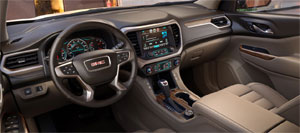 Shifting of the automatic transmission was very slow, with a noticeable lack of momentum each time a new gear was selected. With a short 119-foot stopping average from 60, and only minimal fade; the brakes were very confidence inspiring.
Shifting of the automatic transmission was very slow, with a noticeable lack of momentum each time a new gear was selected. With a short 119-foot stopping average from 60, and only minimal fade; the brakes were very confidence inspiring.
And if you zone out and need the Acadia to apply the brakes for you, it can do that as well, abruptly and consistently; provided you opt to add the Technology Package.
The optional all-wheel-drive system operates as front only if you chose, or leave it in auto. You can also select Sport, Off Road, and Trailer Tow modes.
Of course, the smaller size has taken a toll on interior space. But, you won’t really notice it much in first or second row seating. The 2nd row split bench, or Captain’s chairs, all slide fore and aft, as well as fold easily.
The third row is actually easier to get to, but noticeably tighter when you do. And, seatbelts are down from three to two. So, Acadia’s max body count drops from 8 to 7.
Maximum cargo capacity falls most of all, from 116.1 cubic-ft. to 79.0. Still all these aspects are competitive with Pilot and Highlander.
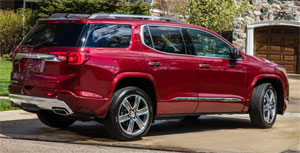 As for how it drives, well lighter is always righter; so it certainly feels more agile. But we’d avoid the I4 unless you’re a lone wolf.
As for how it drives, well lighter is always righter; so it certainly feels more agile. But we’d avoid the I4 unless you’re a lone wolf.
V6 Government Fuel Economy Ratings with all-wheel drive are respectable, at 18-City, 25-Highway, and 20-Combined. We averaged a good 22.1 miles-per-gallon of Regular. For a reasonable Energy Impact Score of 16.5-barrels of oil burned yearly, while emitting 7.2-tons of CO2.
Base pricing is $1,905 lower than before, starting at $29,995. But again, that’s for the I4 and you’re going to want the V6 that will cost you at least $37,090. AWD adds 2-grand more; Acadia Denali starts at $45,845.
The 2017 GMC Acadia is clearly better in every aspect including size. While nothing about the Acadia blew us away with excitement, there’s a lot to like about it.
Yes, the smaller size means Acadia has given up its niche of being a true full-size truckin’ SUV alternative. And, only time will tell if the “going along to get along” strategy will work. But, for now, we think the Acadia will deliver more, from less, for more of you.
Specifications
- Engine: 3.6 liter
- Horsepower: 310
- Torque: 271 lb-ft.
- 0-60 mph: 6.8 seconds
- 1/4 mile: 15.4 seconds @ 92 mph
- EPA: 18 mpg city / 25 mpg highway
- Energy Impact: 16.5 barrels of oil/yr
- CO2 Emissions: 7.2 tons/yr
2025 Genesis G80
New Interior And New Tech Elevates G80 Sedan
Talk about bad timing. This second-generation G80 debuted at the height of a global pandemic. But that hasn’t stopped Genesis or this Bentley-on-a-budget sedan. In fact, since then, Genesis has unveiled a spectacular all-electric version and now given all G80s a makeover. So, let’s find out what a better and better-timed new G80 is ready to deliver.
Breaking into the luxury sedan scene requires going up against traditional brands with long pedigrees and legions of loyal buyers. But Hyundai has never shied away from a challenge, and has made steady progress with their Genesis brand, and hopes that a revised 2025 G80 midsize sedan will be their next step up.
Styling matters more when you’re the upstart, and the Genesis Athletic Elegance theme changes very little for ’25; just a new grille, slightly reshaped bumpers, new wheels ranging from 18 to 20 inches, and an updated color palette. The G80’s unique two-line LED headlamps get revised Micro Lens Array technology that boosts performance while minimizing the brightness for oncoming drivers.
Changes inside are much more significant with an entirely new dash and console, eliminating both the hooded gauge panel and dashtop wide info screen. Merging them together into one 27-inch wide LG panoramic display than runs from behind the steering wheel to over the center stack. There’s a bigger and more comprehensive control panel in the center stack; while the console gets less armrest coverage, more space for storage, and reshaped cupholders. The wider display is still a touchscreen, but there is also a console mounted controller if you prefer to keep it fingerprint free. Both options work well, but the controller is still too easy to confuse with the dial-like shifter.
Materials are on par if not a notch above most European luxury rivals, and there are 18 speakers to crank out 1,400 watts of premium sound from Bang & Olufsen. Top Sport Prestige trim comes with Nappa leather seats, carbon fiber trim, micro-suede materials for the headliner and pillar covers, heated armrests, head-up display, and upgraded active safety features. Front seats are immensely comfortable without feeling overly soft, and there’s plenty of comfort and room for adults in the back seat.
More Bentley than Benz; streaking down the track with European-style solidity that gives you very little indication of the high speed you’re traveling at.
Same powertrains as last year. Base power comes from a 300-horsepower 2.5-liter turbo-four; the upgrade is this 3.5-liter twin-turbo V6 that outputs 375 horsepower and 391 lb-ft of torque. Both are hitched to standard all-wheel drive. At our Mason Dixon Dragway test track, the AWD delivered enough grip for consistent slip-free launches. We hit 60 in 5.0 seconds flat. Run after run, the 3.5T pulled as strong as it sounds. All G80s work with the same paddle-shift eight-speed automatic transmission, and while shifting was silky smooth on the street, here on the track with Sport Mode and wide-open throttle they were noticeably firmer and quicker.
It was a very surreal experience in the cabin. More Bentley than Benz; streaking down the track with European-style solidity that gives you very little indication of the high speed you’re traveling at. For us, that was 105 mph in 13.4 seconds at the quarter. In addition to the G80’s Sport Mode that tightens steering, improves throttle response, adjusts shifting points, firms up the suspension, and reconfigures stability system parameters; Sport Prestige trim adds rear-wheel steering and an electronic limited slip differential. But, even with all of that, it didn’t feel overly sporty in our handling course. Now, we were able to comfortably carry quite a bit of speed through the cones, but there was just an overall soft, somewhat disconnected and heavy presence that had us unsure of how hard we could push. Sport Prestige also adds upgraded performance brakes. They were plenty capable, bringing this 4,600-lbs. luxury liner consistently down from 60 in just 104 feet with little fade.
Government Fuel Economy Ratings for the six-cylinder are 16 City, 24 Highway, and 19 Combined. We averaged a good 21.3 mpg of Premium. Still, that’s a slightly below average Energy Impact Score, using 15.7 barrels of oil annually with 7.8 tons of CO2 emissions.
Considering the amount of luxury packed into the G80, its $58,350 starting price, even though slightly higher than last year, remains pretty remarkable. It’s a substantial step up to the 3.5T though, as it begins at $70,850.
Genesis has existed as a standalone luxury brand for just less than a decade, and it has indeed been making steady progress into what is surely the hardest segment of all to master. The 2025 Genesis G80 sedan continues to impress and is a great option for luxury-minded buyers who prioritize true value over badges.
Specifications
As Tested
- Engine: 3.5-liter twin-turbo V6
- Transmission: eight-speed automatic
- Horsepower: 375
- Torque: 391 lb-ft
- EPA: 16 City | 24 Highway | 19 Combined
- 0-60 mph: 5.0 seconds
- 1/4 Mile: 13.4 seconds at 105 mph
- Braking, 60-0 (avg.): 104 feet
- MW Fuel Economy: 21.3 mpg (Premium)







